Bidirectional electro-optical device for coupling light-signals into and out of a waveguide
a waveguide and light-signal technology, applied in the direction of optical waveguide light guides, instruments, optics, etc., can solve the problems of unfavorable interference or scattered signals, very difficult alignment, and very difficult to achieve technicalally, so as to reduce mutual influence or interference
- Summary
- Abstract
- Description
- Claims
- Application Information
AI Technical Summary
Benefits of technology
Problems solved by technology
Method used
Image
Examples
Embodiment Construction
[0037] In the figures, mutually corresponding or similar features have the same reference symbols.
[0038]FIGS. 1a, 1b and 2 show a bidirectional electro-optical transmitting and receiving module 20. The module 20 has a basic carrier plate 2 as carrier, which is formed as a silicon submount, by way of example. All the essential components of the module 20 are arranged on one side, the top side 2′ illustrated in the figures, of the carrier 2.
[0039] A laser diode 1 serves as a light transmitter, whose signal output is recorded by the monitor diode 8. In the further beam course, light signals of the laser diode 1 are detracted by a transmitter microlens 6 and radiate through a wavelength-selective beam splitter 7 before the light signals are coupled out of the module without beam deflection through the microlens 4 (FIG. 2). Light signals that come from the coupling-out direction and are to be detected by the module 20 firstly pass through the microlens 4, are deflected by approximately...
PUM
 Login to View More
Login to View More Abstract
Description
Claims
Application Information
 Login to View More
Login to View More - R&D
- Intellectual Property
- Life Sciences
- Materials
- Tech Scout
- Unparalleled Data Quality
- Higher Quality Content
- 60% Fewer Hallucinations
Browse by: Latest US Patents, China's latest patents, Technical Efficacy Thesaurus, Application Domain, Technology Topic, Popular Technical Reports.
© 2025 PatSnap. All rights reserved.Legal|Privacy policy|Modern Slavery Act Transparency Statement|Sitemap|About US| Contact US: help@patsnap.com



